Related Research Articles

An icon is a religious work of art, most commonly a painting, in the cultures of the Eastern Orthodox, Oriental Orthodox, and Catholic churches. They are not simply artworks; "an icon is a sacred image used in religious devotion". The most common subjects include Jesus, Mary, saints, and angels. Although especially associated with portrait-style images concentrating on one or two main figures, the term also covers most of the religious images in a variety of artistic media produced by Eastern Christianity, including narrative scenes, usually from the Bible or the lives of saints.
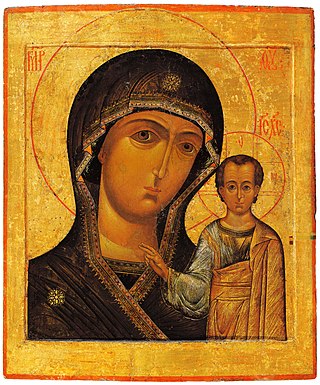
Theotokos is a title of Mary, mother of Jesus, used especially in Eastern Christianity. The usual Latin translations are Dei Genitrix or Deipara. Familiar English translations are "Mother of God" or "God-bearer" – but these both have different literal equivalents in Greek, Μήτηρ Θεοῦ and Θεοφόρος.

The Dormition of the Mother of God is a Great Feast of the Eastern Orthodox, Oriental Orthodox, and Eastern Catholic Churches. It celebrates the "falling asleep" (death) of Mary the Theotokos, and her being taken up into heaven. It is celebrated on 15 August as the Feast of the Dormition of the Mother of God. The Armenian Apostolic Church celebrates the Dormition not on a fixed date, but on the Sunday nearest 15 August. In Western Churches the corresponding feast is known as the Assumption of Mary, with the exception of the Scottish Episcopal Church, which has traditionally celebrated the Falling Asleep of the Blessed Virgin Mary on 15 August.
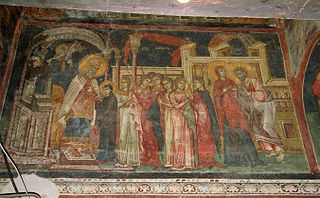
The Presentation of the Blessed Virgin Mary, known in the East as The Entry of the Most Holy Theotokos into the Temple, is a liturgical feast celebrated on November 21 by the Catholic, Eastern Orthodox, and some Anglo-Catholic Churches.

The Virgin of Vladimir, also known as Vladimir Mother of God, Our Lady of Vladimir, and the Theotokos of Vladimir, is a 12th-century Byzantine icon depicting the Virgin and Child and an early example of the Eleusa iconographic type. It is one of the most culturally significant and celebrated pieces of art in Russian history. Many consider it a national palladium with several miracles of historical importance to Russia being attributed to the icon. Following its near destruction in the thirteenth century, the work has been restored at least five times.

Church of the Sepulchre of Saint Mary, also Tomb of the Virgin Mary or the Church of the Assumption, is a Christian church built around an ancient Jewish rock-cut tomb in the Kidron Valley – at the foot of Mount of Olives, in Jerusalem – believed by Eastern Christians to be the burial place of Mary, the mother of Jesus. The Status Quo, a 250-year old understanding between religious communities, applies to the site.

Marian hymns are Christian songs focused on Mary, mother of Jesus. They are used in both devotional and liturgical services, particularly by the Roman Catholic, Eastern Orthodox, Oriental Orthodox, Anglican, and Lutheran churches. They are often used in the month of May devotions. Some have also been adopted as Christmas hymns. Marian hymns are not popular among some Protestants, as they see Marian veneration as idolatry. However, the practice is very common among Christians of Catholic traditions, and a key component of the Eastern Orthodox liturgy. There are many more hymns to Mary within the Eastern Orthodox yearly cycle of liturgy than in Roman Catholic liturgy.

May 27 - Eastern Orthodox Church calendar - May 29

Sumela Monastery is a Greek Orthodox monastery dedicated to Mary located at Karadağ within the Pontic Mountains, in the Maçka district of Trabzon Province in modern Turkey.

Saidnaya is a city located in the mountains, 1,500 m (4,900 ft) above sea level, 27 km (17 mi) north of the city of Damascus in Syria. It is the home of a Greek Orthodox monastery traditionally held to have been founded by Byzantine emperor Justinian I, and where a renowned icon of the Virgin Mary is revered by both Christians and Muslims to this day. According to the Syria Central Bureau of Statistics (CBS), Saidnaya had a population of 25,194 in the 2004 census.

August 14 - Eastern Orthodox liturgical calendar - August 16

Lazarus, surnamed Zographos, is a 9th-century Byzantine Christian saint. He is also known as Lazarus the Painter and Lazarus the Iconographer. Born in Armenia on November 17, 810, he lived before and during the second period of Byzantine Iconoclasm. Lazarus was the first saint to be canonized specifically as an iconographer. He was later followed by Saint Catherine of Bologna.
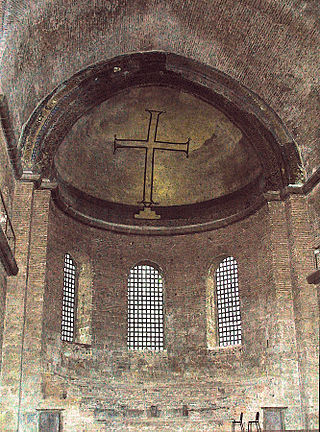
The Byzantine Iconoclasm were two periods in the history of the Byzantine Empire when the use of religious images or icons was opposed by religious and imperial authorities within the Ecumenical Patriarchate and the temporal imperial hierarchy. The First Iconoclasm, as it is sometimes called, occurred between about 726 and 787, while the Second Iconoclasm occurred between 814 and 842. According to the traditional view, Byzantine Iconoclasm was started by a ban on religious images promulgated by the Byzantine Emperor Leo III the Isaurian, and continued under his successors. It was accompanied by widespread destruction of religious images and persecution of supporters of the veneration of images. The Papacy remained firmly in support of the use of religious images throughout the period, and the whole episode widened the growing divergence between the Byzantine and Carolingian traditions in what was still a unified European Church, as well as facilitating the reduction or removal of Byzantine political control over parts of the Italian Peninsula.
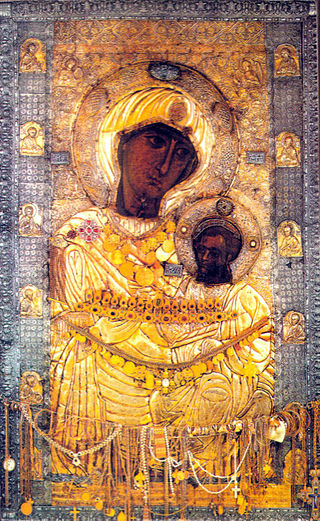
The Panagia Portaitissa also known as the Iviron Theotokos or Iverskaya in Russian, is an Eastern Orthodox icon of the Virgin Mary in the Georgian Iviron monastery on Mount Athos in Greece, where it is believed to have been since the year 999. According to the sacred tradition of the Eastern Orthodox Church it was painted by Luke the Evangelist. The icon is referred to as "Wonderworking" meaning that numerous miracles have been attributed to the intercession of the Theotokos by persons praying before it. The synaxis for this icon is on February 12, as well as on Bright Tuesday, and also on October 13 for the translation to Moscow of the Iveron icon.

The Mother of God of the Life-giving Spring or Life-giving Font is an epithet of the Holy Theotokos that originated with her revelation of a sacred spring in Valoukli, Constantinople, to a soldier named Leo Marcellus, who later became Byzantine Emperor Leo I (457-474). Leo built the historic Church of St. Mary of the Spring over this site, which witnessed numerous miraculous healings over the centuries, through her intercessions, becoming one of the most important pilgrimage sites in Greek Orthodoxy. Thus the term "Life-giving Font" became an epithet of the Holy Theotokos and she was represented as such in iconography.
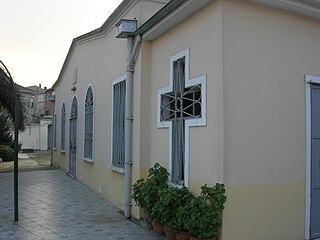
The Church of Saint Mary of Blachernae is an Eastern Orthodox church in Mustafa Paşa Bostanı Sokak in Ayvansaray in the Fatih district of Istanbul, just inside the old walled city. During the latter part of the Byzantine period, the original church complex on the site was one of the most important sanctuaries of Byzantium, arguably outstripping Hagia Sophia in importance due to its proximity to the Palace of the Blachernae. The Byzantine church complex was destroyed in 1434, and in the nineteenth century a small new church was built on the site. Today it is protected by a high wall, and fronted by a garden.

Bogorodica Trojeručica or simply Trojeručica is an Eastern Orthodox wonderworking icon believed to have been produced in the 8th century in Palestine by John of Damascus. It depicts Theotokos with young Jesus in the hodegetria position, and is covered with a riza. On the back of the icon is the painting of St Nicholas. It is today found in the Hilandar Monastery on Mount Athos, Greece, and is the most important icon of the Serbian Orthodox Church.

The Cincture of the Theotokos is believed to be a relic of the Theotokos, now in the Vatopedi monastery on Mount Athos, which is venerated by the Holy Eastern Orthodox Church. The word "cincture" is sometimes also translated as "belt", "sash" or "girdle". It is the Orthodox equivalent of the Girdle of Thomas in the Western church, and the Syriac Holy Girdle. Its feast day is September 13.

The Monastery of the Mother of God at the Spring or simply Zoödochos Pege is an Eastern Orthodox sanctuary in Istanbul, Turkey. The present church, built in 1835, bears the same dedication as the shrine erected in this place between the end of the fifth and the beginning of the sixth century. After several renovations, this building was destroyed in the first half of the fifteenth century by the Ottomans. The complex got its name from a nearby holy spring, reputed to have healing properties. For almost fifteen hundred years, this sanctuary has been one of the most important pilgrimage sites of Greek Orthodoxy.
This is a timeline of the presence of Eastern Orthodoxy in Greece from 717 to 1204. The history of Greece traditionally encompasses the study of the Greek people, the areas they ruled historically, as well as the territory now composing the modern state of Greece.